Competitive Strategy Essays 2022
VerifiedAdded on 2022/09/22
|8
|2031
|23
Essay
AI Summary
Contribute Materials
Your contribution can guide someone’s learning journey. Share your
documents today.
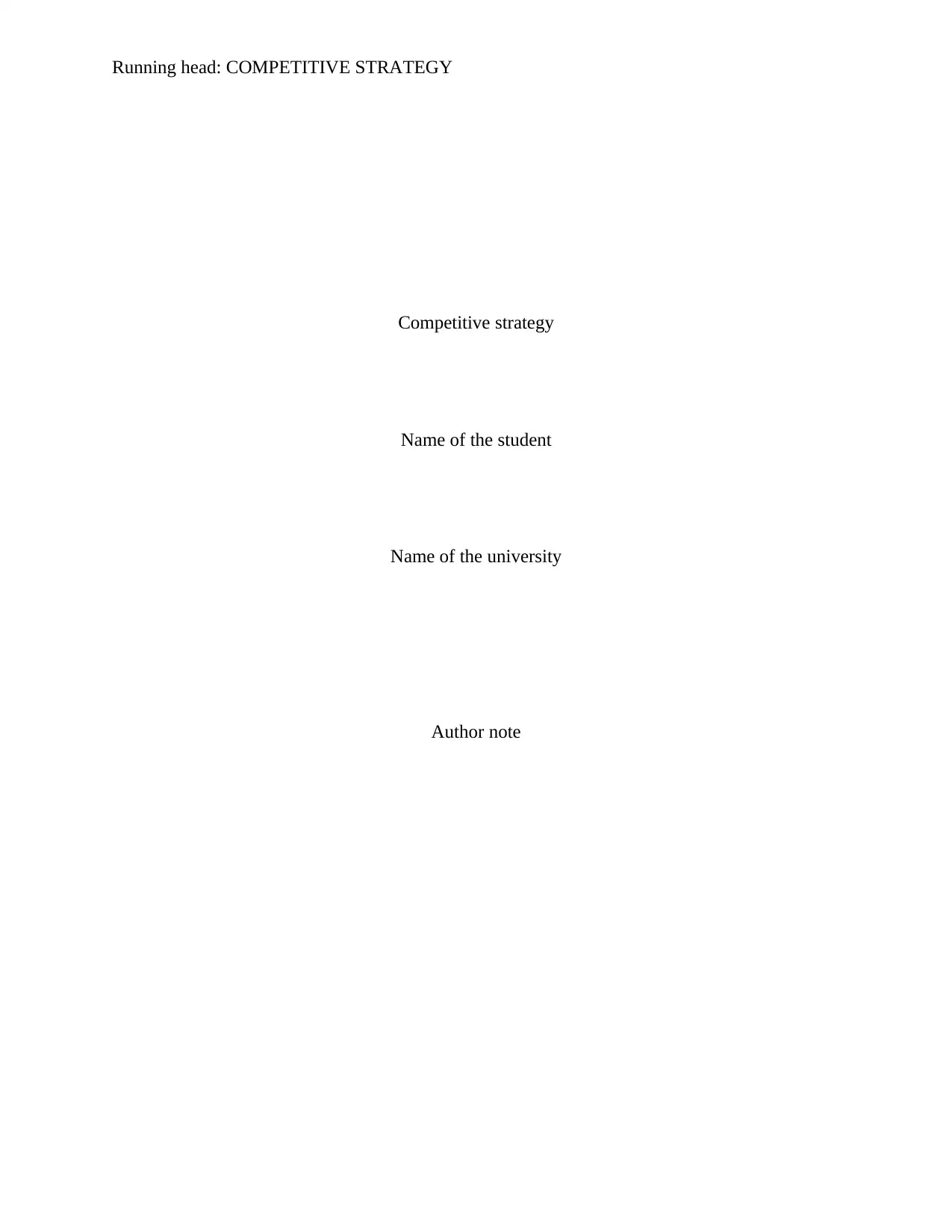
Running head: COMPETITIVE STRATEGY
Competitive strategy
Name of the student
Name of the university
Author note
Competitive strategy
Name of the student
Name of the university
Author note
Secure Best Marks with AI Grader
Need help grading? Try our AI Grader for instant feedback on your assignments.
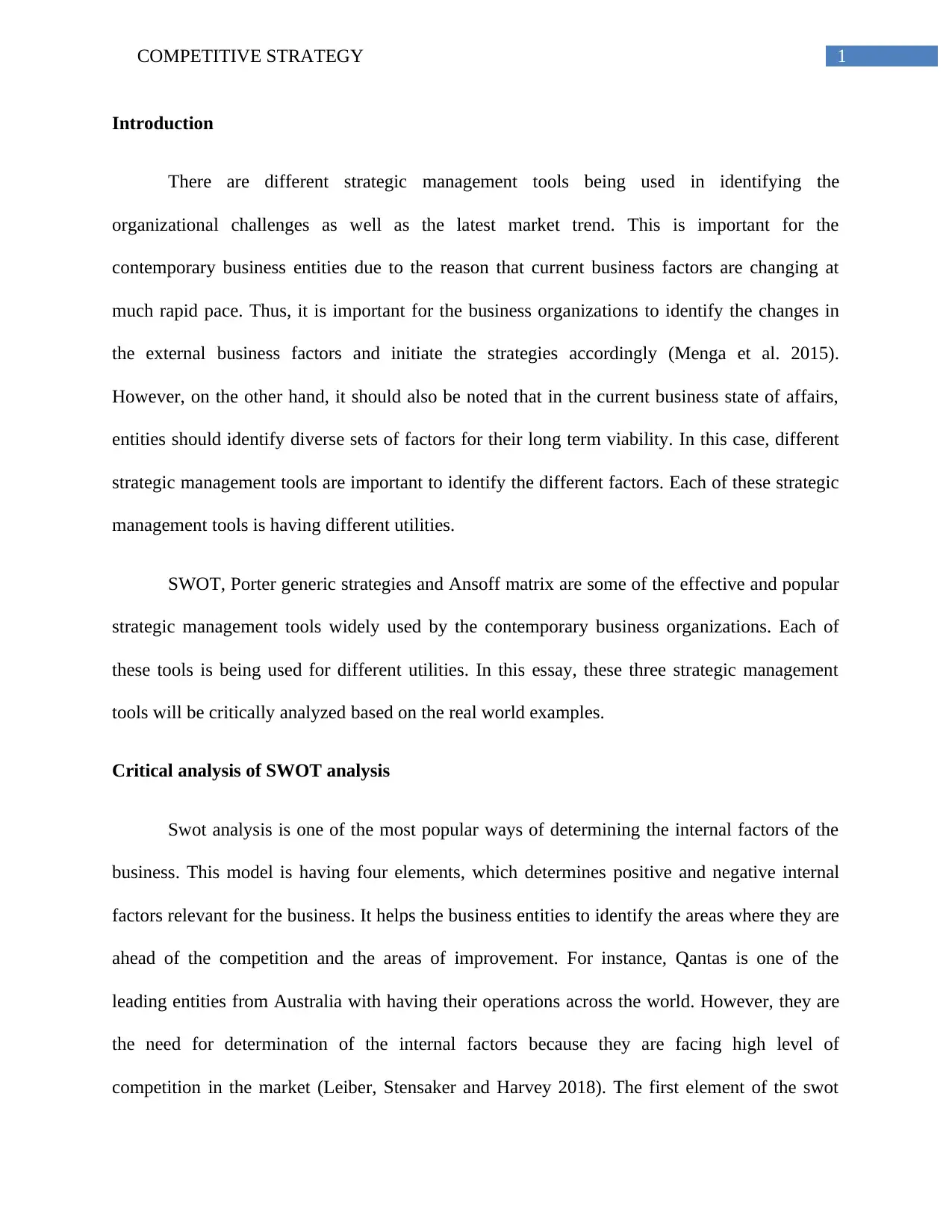
1COMPETITIVE STRATEGY
Introduction
There are different strategic management tools being used in identifying the
organizational challenges as well as the latest market trend. This is important for the
contemporary business entities due to the reason that current business factors are changing at
much rapid pace. Thus, it is important for the business organizations to identify the changes in
the external business factors and initiate the strategies accordingly (Menga et al. 2015).
However, on the other hand, it should also be noted that in the current business state of affairs,
entities should identify diverse sets of factors for their long term viability. In this case, different
strategic management tools are important to identify the different factors. Each of these strategic
management tools is having different utilities.
SWOT, Porter generic strategies and Ansoff matrix are some of the effective and popular
strategic management tools widely used by the contemporary business organizations. Each of
these tools is being used for different utilities. In this essay, these three strategic management
tools will be critically analyzed based on the real world examples.
Critical analysis of SWOT analysis
Swot analysis is one of the most popular ways of determining the internal factors of the
business. This model is having four elements, which determines positive and negative internal
factors relevant for the business. It helps the business entities to identify the areas where they are
ahead of the competition and the areas of improvement. For instance, Qantas is one of the
leading entities from Australia with having their operations across the world. However, they are
the need for determination of the internal factors because they are facing high level of
competition in the market (Leiber, Stensaker and Harvey 2018). The first element of the swot
Introduction
There are different strategic management tools being used in identifying the
organizational challenges as well as the latest market trend. This is important for the
contemporary business entities due to the reason that current business factors are changing at
much rapid pace. Thus, it is important for the business organizations to identify the changes in
the external business factors and initiate the strategies accordingly (Menga et al. 2015).
However, on the other hand, it should also be noted that in the current business state of affairs,
entities should identify diverse sets of factors for their long term viability. In this case, different
strategic management tools are important to identify the different factors. Each of these strategic
management tools is having different utilities.
SWOT, Porter generic strategies and Ansoff matrix are some of the effective and popular
strategic management tools widely used by the contemporary business organizations. Each of
these tools is being used for different utilities. In this essay, these three strategic management
tools will be critically analyzed based on the real world examples.
Critical analysis of SWOT analysis
Swot analysis is one of the most popular ways of determining the internal factors of the
business. This model is having four elements, which determines positive and negative internal
factors relevant for the business. It helps the business entities to identify the areas where they are
ahead of the competition and the areas of improvement. For instance, Qantas is one of the
leading entities from Australia with having their operations across the world. However, they are
the need for determination of the internal factors because they are facing high level of
competition in the market (Leiber, Stensaker and Harvey 2018). The first element of the swot
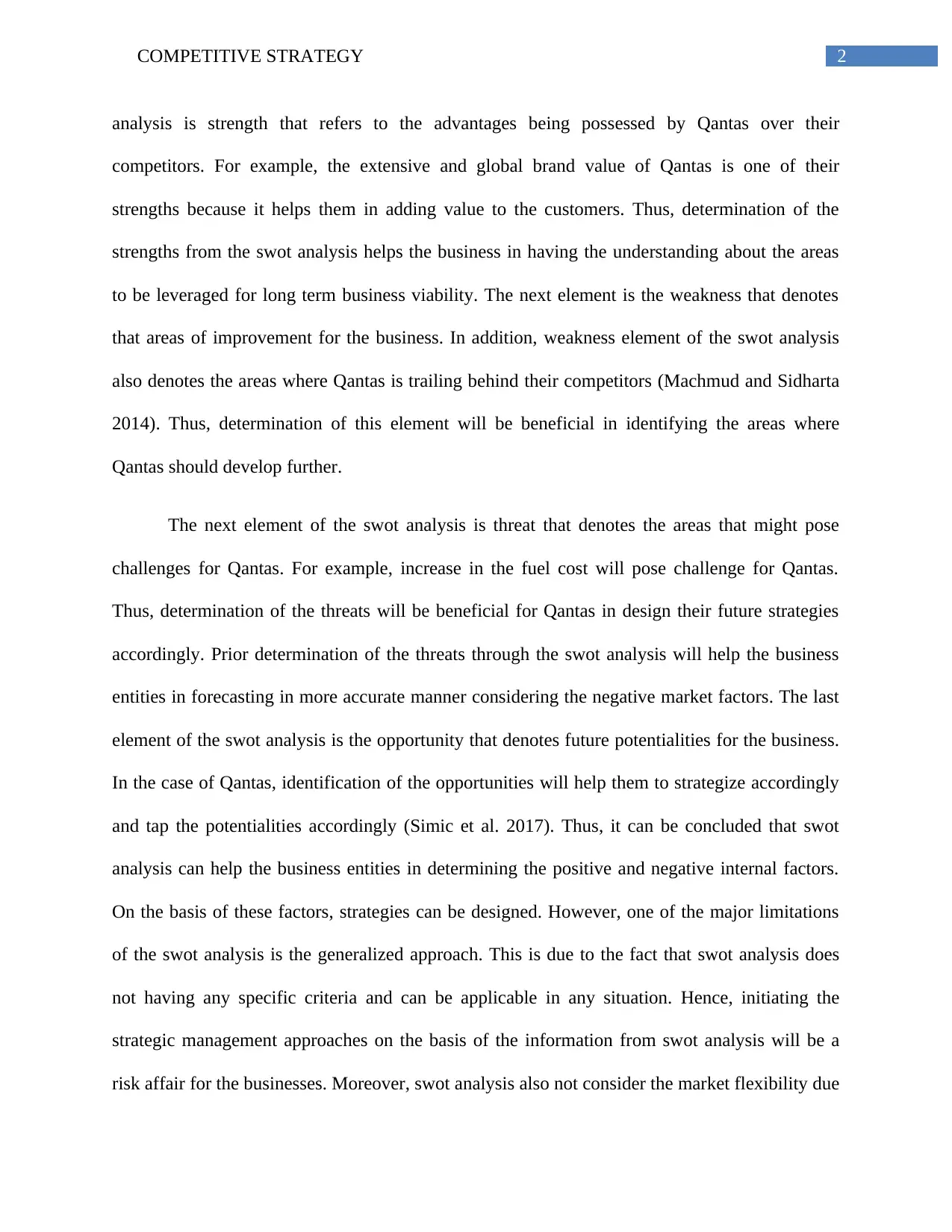
2COMPETITIVE STRATEGY
analysis is strength that refers to the advantages being possessed by Qantas over their
competitors. For example, the extensive and global brand value of Qantas is one of their
strengths because it helps them in adding value to the customers. Thus, determination of the
strengths from the swot analysis helps the business in having the understanding about the areas
to be leveraged for long term business viability. The next element is the weakness that denotes
that areas of improvement for the business. In addition, weakness element of the swot analysis
also denotes the areas where Qantas is trailing behind their competitors (Machmud and Sidharta
2014). Thus, determination of this element will be beneficial in identifying the areas where
Qantas should develop further.
The next element of the swot analysis is threat that denotes the areas that might pose
challenges for Qantas. For example, increase in the fuel cost will pose challenge for Qantas.
Thus, determination of the threats will be beneficial for Qantas in design their future strategies
accordingly. Prior determination of the threats through the swot analysis will help the business
entities in forecasting in more accurate manner considering the negative market factors. The last
element of the swot analysis is the opportunity that denotes future potentialities for the business.
In the case of Qantas, identification of the opportunities will help them to strategize accordingly
and tap the potentialities accordingly (Simic et al. 2017). Thus, it can be concluded that swot
analysis can help the business entities in determining the positive and negative internal factors.
On the basis of these factors, strategies can be designed. However, one of the major limitations
of the swot analysis is the generalized approach. This is due to the fact that swot analysis does
not having any specific criteria and can be applicable in any situation. Hence, initiating the
strategic management approaches on the basis of the information from swot analysis will be a
risk affair for the businesses. Moreover, swot analysis also not consider the market flexibility due
analysis is strength that refers to the advantages being possessed by Qantas over their
competitors. For example, the extensive and global brand value of Qantas is one of their
strengths because it helps them in adding value to the customers. Thus, determination of the
strengths from the swot analysis helps the business in having the understanding about the areas
to be leveraged for long term business viability. The next element is the weakness that denotes
that areas of improvement for the business. In addition, weakness element of the swot analysis
also denotes the areas where Qantas is trailing behind their competitors (Machmud and Sidharta
2014). Thus, determination of this element will be beneficial in identifying the areas where
Qantas should develop further.
The next element of the swot analysis is threat that denotes the areas that might pose
challenges for Qantas. For example, increase in the fuel cost will pose challenge for Qantas.
Thus, determination of the threats will be beneficial for Qantas in design their future strategies
accordingly. Prior determination of the threats through the swot analysis will help the business
entities in forecasting in more accurate manner considering the negative market factors. The last
element of the swot analysis is the opportunity that denotes future potentialities for the business.
In the case of Qantas, identification of the opportunities will help them to strategize accordingly
and tap the potentialities accordingly (Simic et al. 2017). Thus, it can be concluded that swot
analysis can help the business entities in determining the positive and negative internal factors.
On the basis of these factors, strategies can be designed. However, one of the major limitations
of the swot analysis is the generalized approach. This is due to the fact that swot analysis does
not having any specific criteria and can be applicable in any situation. Hence, initiating the
strategic management approaches on the basis of the information from swot analysis will be a
risk affair for the businesses. Moreover, swot analysis also not consider the market flexibility due
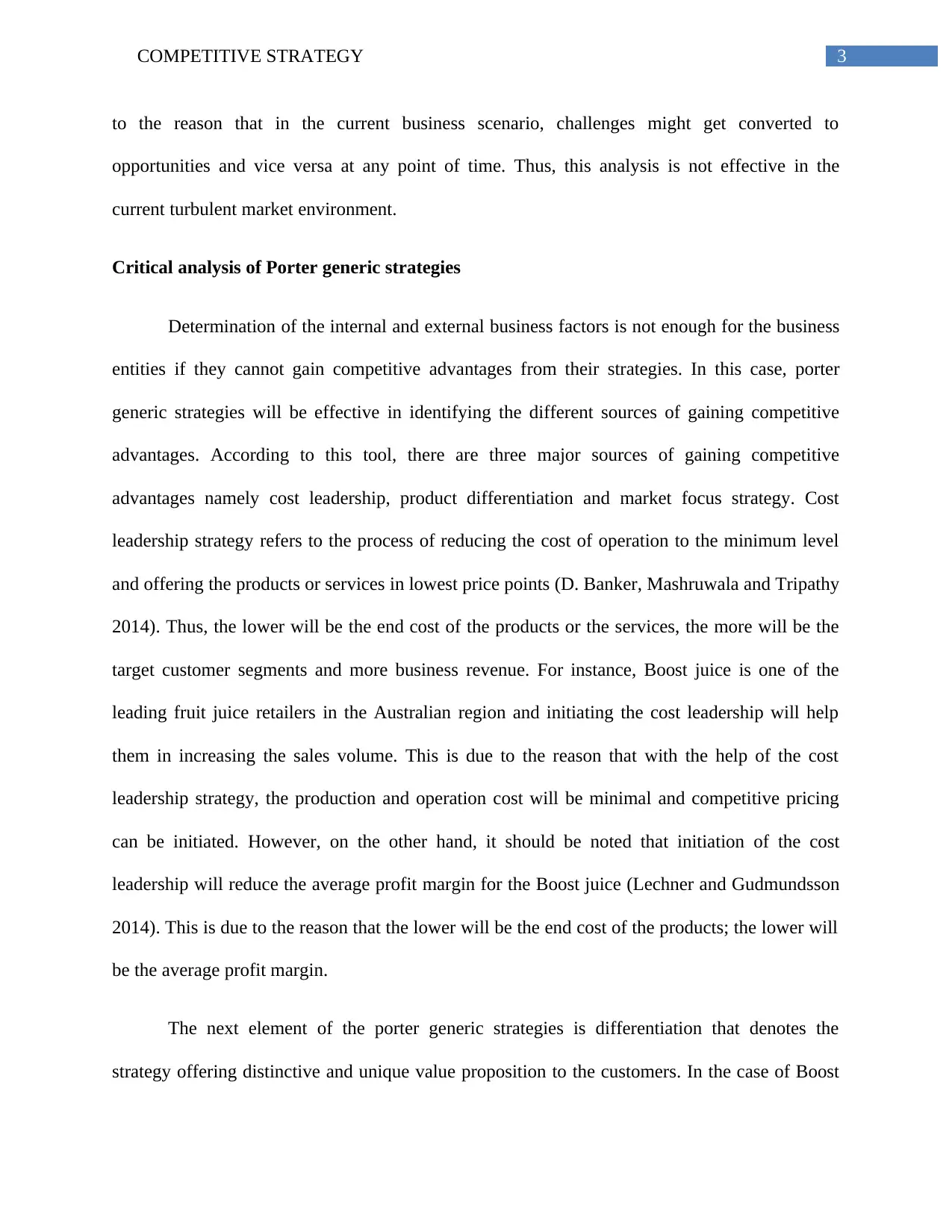
3COMPETITIVE STRATEGY
to the reason that in the current business scenario, challenges might get converted to
opportunities and vice versa at any point of time. Thus, this analysis is not effective in the
current turbulent market environment.
Critical analysis of Porter generic strategies
Determination of the internal and external business factors is not enough for the business
entities if they cannot gain competitive advantages from their strategies. In this case, porter
generic strategies will be effective in identifying the different sources of gaining competitive
advantages. According to this tool, there are three major sources of gaining competitive
advantages namely cost leadership, product differentiation and market focus strategy. Cost
leadership strategy refers to the process of reducing the cost of operation to the minimum level
and offering the products or services in lowest price points (D. Banker, Mashruwala and Tripathy
2014). Thus, the lower will be the end cost of the products or the services, the more will be the
target customer segments and more business revenue. For instance, Boost juice is one of the
leading fruit juice retailers in the Australian region and initiating the cost leadership will help
them in increasing the sales volume. This is due to the reason that with the help of the cost
leadership strategy, the production and operation cost will be minimal and competitive pricing
can be initiated. However, on the other hand, it should be noted that initiation of the cost
leadership will reduce the average profit margin for the Boost juice (Lechner and Gudmundsson
2014). This is due to the reason that the lower will be the end cost of the products; the lower will
be the average profit margin.
The next element of the porter generic strategies is differentiation that denotes the
strategy offering distinctive and unique value proposition to the customers. In the case of Boost
to the reason that in the current business scenario, challenges might get converted to
opportunities and vice versa at any point of time. Thus, this analysis is not effective in the
current turbulent market environment.
Critical analysis of Porter generic strategies
Determination of the internal and external business factors is not enough for the business
entities if they cannot gain competitive advantages from their strategies. In this case, porter
generic strategies will be effective in identifying the different sources of gaining competitive
advantages. According to this tool, there are three major sources of gaining competitive
advantages namely cost leadership, product differentiation and market focus strategy. Cost
leadership strategy refers to the process of reducing the cost of operation to the minimum level
and offering the products or services in lowest price points (D. Banker, Mashruwala and Tripathy
2014). Thus, the lower will be the end cost of the products or the services, the more will be the
target customer segments and more business revenue. For instance, Boost juice is one of the
leading fruit juice retailers in the Australian region and initiating the cost leadership will help
them in increasing the sales volume. This is due to the reason that with the help of the cost
leadership strategy, the production and operation cost will be minimal and competitive pricing
can be initiated. However, on the other hand, it should be noted that initiation of the cost
leadership will reduce the average profit margin for the Boost juice (Lechner and Gudmundsson
2014). This is due to the reason that the lower will be the end cost of the products; the lower will
be the average profit margin.
The next element of the porter generic strategies is differentiation that denotes the
strategy offering distinctive and unique value proposition to the customers. In the case of Boost
Secure Best Marks with AI Grader
Need help grading? Try our AI Grader for instant feedback on your assignments.
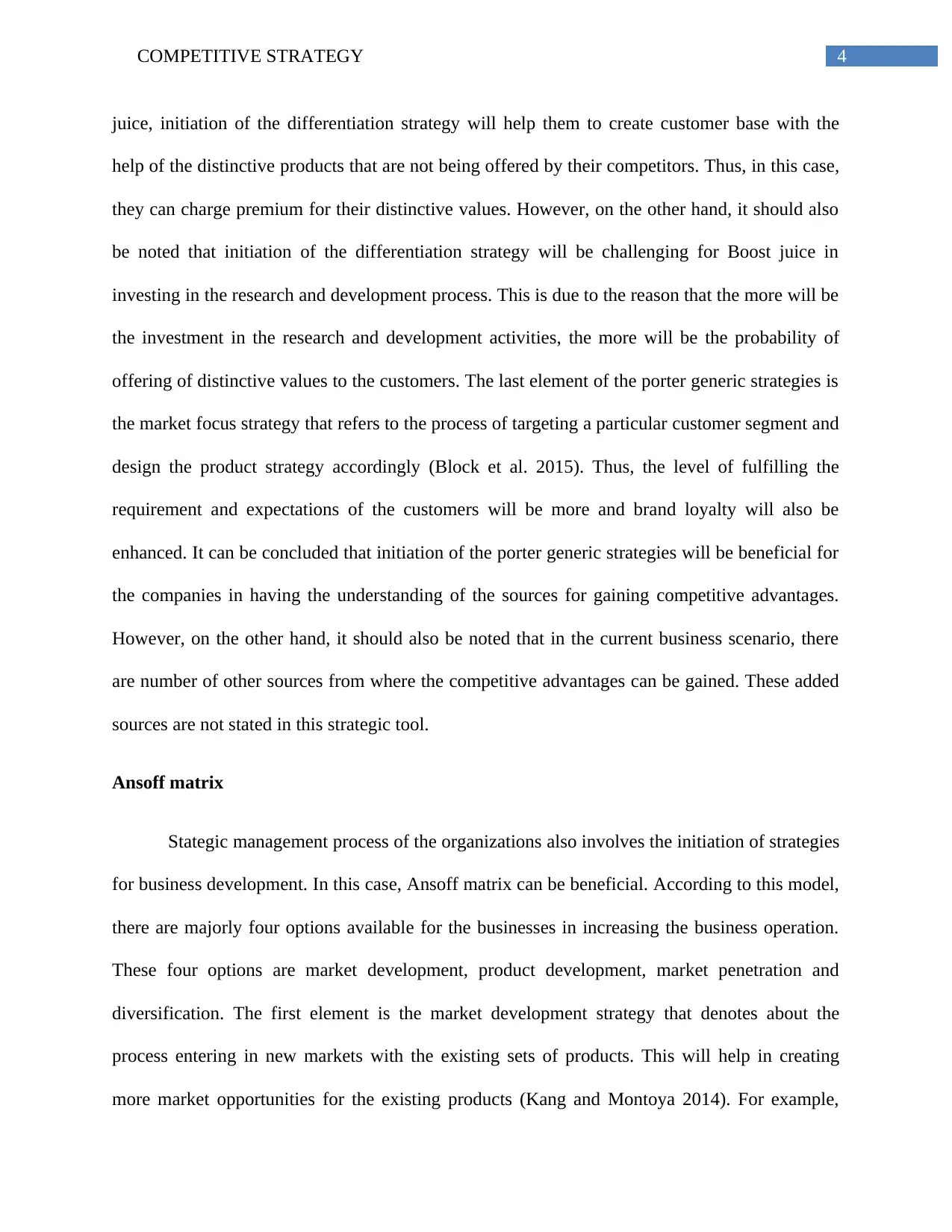
4COMPETITIVE STRATEGY
juice, initiation of the differentiation strategy will help them to create customer base with the
help of the distinctive products that are not being offered by their competitors. Thus, in this case,
they can charge premium for their distinctive values. However, on the other hand, it should also
be noted that initiation of the differentiation strategy will be challenging for Boost juice in
investing in the research and development process. This is due to the reason that the more will be
the investment in the research and development activities, the more will be the probability of
offering of distinctive values to the customers. The last element of the porter generic strategies is
the market focus strategy that refers to the process of targeting a particular customer segment and
design the product strategy accordingly (Block et al. 2015). Thus, the level of fulfilling the
requirement and expectations of the customers will be more and brand loyalty will also be
enhanced. It can be concluded that initiation of the porter generic strategies will be beneficial for
the companies in having the understanding of the sources for gaining competitive advantages.
However, on the other hand, it should also be noted that in the current business scenario, there
are number of other sources from where the competitive advantages can be gained. These added
sources are not stated in this strategic tool.
Ansoff matrix
Stategic management process of the organizations also involves the initiation of strategies
for business development. In this case, Ansoff matrix can be beneficial. According to this model,
there are majorly four options available for the businesses in increasing the business operation.
These four options are market development, product development, market penetration and
diversification. The first element is the market development strategy that denotes about the
process entering in new markets with the existing sets of products. This will help in creating
more market opportunities for the existing products (Kang and Montoya 2014). For example,
juice, initiation of the differentiation strategy will help them to create customer base with the
help of the distinctive products that are not being offered by their competitors. Thus, in this case,
they can charge premium for their distinctive values. However, on the other hand, it should also
be noted that initiation of the differentiation strategy will be challenging for Boost juice in
investing in the research and development process. This is due to the reason that the more will be
the investment in the research and development activities, the more will be the probability of
offering of distinctive values to the customers. The last element of the porter generic strategies is
the market focus strategy that refers to the process of targeting a particular customer segment and
design the product strategy accordingly (Block et al. 2015). Thus, the level of fulfilling the
requirement and expectations of the customers will be more and brand loyalty will also be
enhanced. It can be concluded that initiation of the porter generic strategies will be beneficial for
the companies in having the understanding of the sources for gaining competitive advantages.
However, on the other hand, it should also be noted that in the current business scenario, there
are number of other sources from where the competitive advantages can be gained. These added
sources are not stated in this strategic tool.
Ansoff matrix
Stategic management process of the organizations also involves the initiation of strategies
for business development. In this case, Ansoff matrix can be beneficial. According to this model,
there are majorly four options available for the businesses in increasing the business operation.
These four options are market development, product development, market penetration and
diversification. The first element is the market development strategy that denotes about the
process entering in new markets with the existing sets of products. This will help in creating
more market opportunities for the existing products (Kang and Montoya 2014). For example,
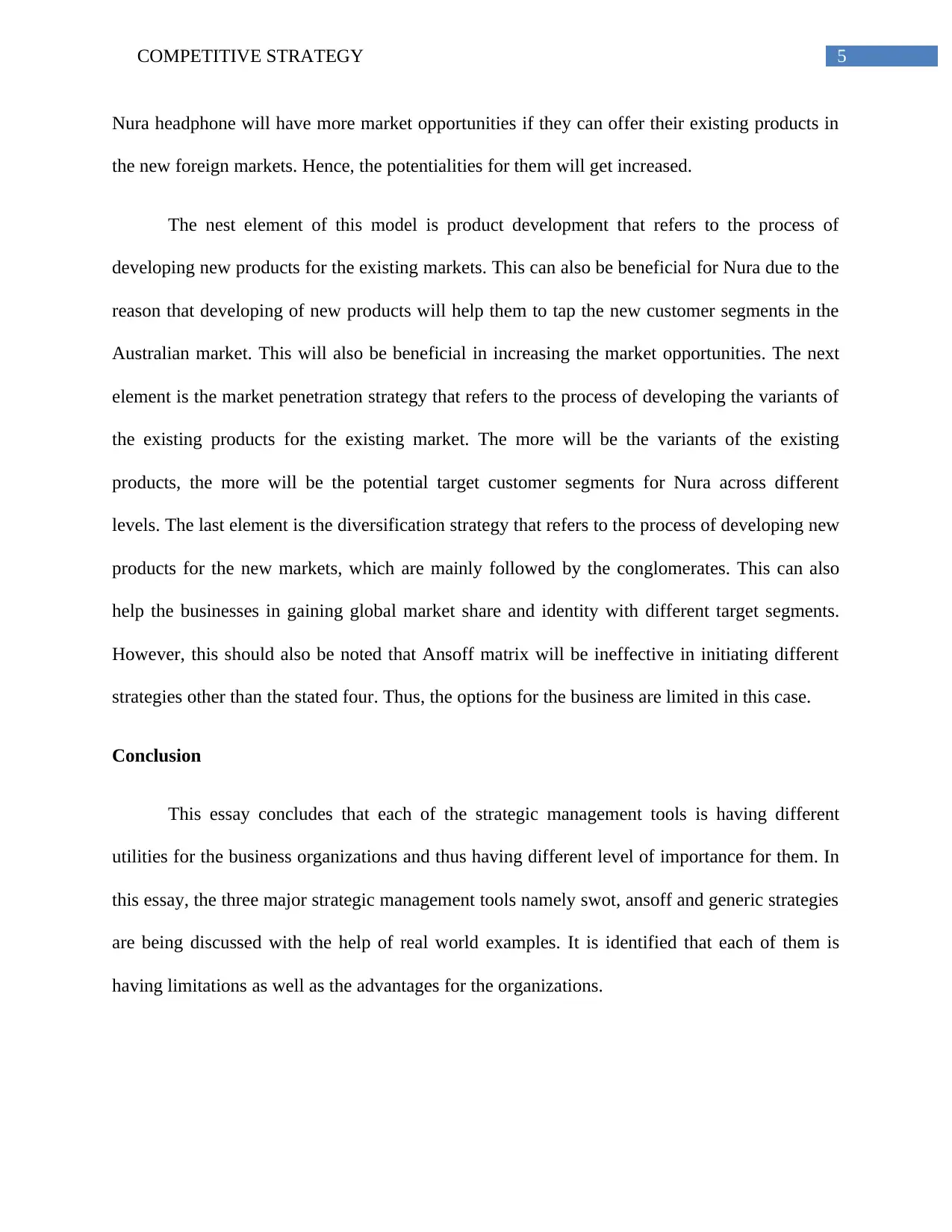
5COMPETITIVE STRATEGY
Nura headphone will have more market opportunities if they can offer their existing products in
the new foreign markets. Hence, the potentialities for them will get increased.
The nest element of this model is product development that refers to the process of
developing new products for the existing markets. This can also be beneficial for Nura due to the
reason that developing of new products will help them to tap the new customer segments in the
Australian market. This will also be beneficial in increasing the market opportunities. The next
element is the market penetration strategy that refers to the process of developing the variants of
the existing products for the existing market. The more will be the variants of the existing
products, the more will be the potential target customer segments for Nura across different
levels. The last element is the diversification strategy that refers to the process of developing new
products for the new markets, which are mainly followed by the conglomerates. This can also
help the businesses in gaining global market share and identity with different target segments.
However, this should also be noted that Ansoff matrix will be ineffective in initiating different
strategies other than the stated four. Thus, the options for the business are limited in this case.
Conclusion
This essay concludes that each of the strategic management tools is having different
utilities for the business organizations and thus having different level of importance for them. In
this essay, the three major strategic management tools namely swot, ansoff and generic strategies
are being discussed with the help of real world examples. It is identified that each of them is
having limitations as well as the advantages for the organizations.
Nura headphone will have more market opportunities if they can offer their existing products in
the new foreign markets. Hence, the potentialities for them will get increased.
The nest element of this model is product development that refers to the process of
developing new products for the existing markets. This can also be beneficial for Nura due to the
reason that developing of new products will help them to tap the new customer segments in the
Australian market. This will also be beneficial in increasing the market opportunities. The next
element is the market penetration strategy that refers to the process of developing the variants of
the existing products for the existing market. The more will be the variants of the existing
products, the more will be the potential target customer segments for Nura across different
levels. The last element is the diversification strategy that refers to the process of developing new
products for the new markets, which are mainly followed by the conglomerates. This can also
help the businesses in gaining global market share and identity with different target segments.
However, this should also be noted that Ansoff matrix will be ineffective in initiating different
strategies other than the stated four. Thus, the options for the business are limited in this case.
Conclusion
This essay concludes that each of the strategic management tools is having different
utilities for the business organizations and thus having different level of importance for them. In
this essay, the three major strategic management tools namely swot, ansoff and generic strategies
are being discussed with the help of real world examples. It is identified that each of them is
having limitations as well as the advantages for the organizations.
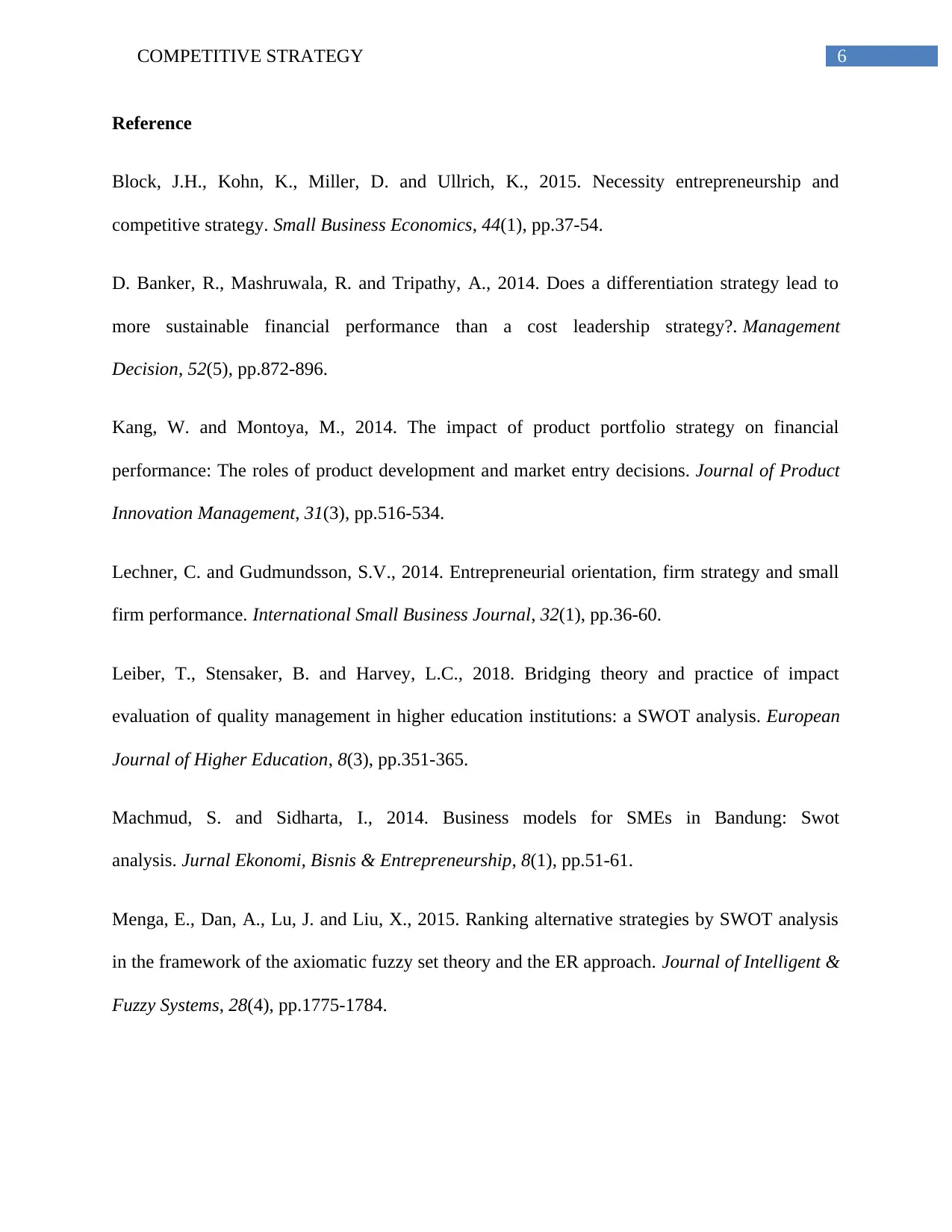
6COMPETITIVE STRATEGY
Reference
Block, J.H., Kohn, K., Miller, D. and Ullrich, K., 2015. Necessity entrepreneurship and
competitive strategy. Small Business Economics, 44(1), pp.37-54.
D. Banker, R., Mashruwala, R. and Tripathy, A., 2014. Does a differentiation strategy lead to
more sustainable financial performance than a cost leadership strategy?. Management
Decision, 52(5), pp.872-896.
Kang, W. and Montoya, M., 2014. The impact of product portfolio strategy on financial
performance: The roles of product development and market entry decisions. Journal of Product
Innovation Management, 31(3), pp.516-534.
Lechner, C. and Gudmundsson, S.V., 2014. Entrepreneurial orientation, firm strategy and small
firm performance. International Small Business Journal, 32(1), pp.36-60.
Leiber, T., Stensaker, B. and Harvey, L.C., 2018. Bridging theory and practice of impact
evaluation of quality management in higher education institutions: a SWOT analysis. European
Journal of Higher Education, 8(3), pp.351-365.
Machmud, S. and Sidharta, I., 2014. Business models for SMEs in Bandung: Swot
analysis. Jurnal Ekonomi, Bisnis & Entrepreneurship, 8(1), pp.51-61.
Menga, E., Dan, A., Lu, J. and Liu, X., 2015. Ranking alternative strategies by SWOT analysis
in the framework of the axiomatic fuzzy set theory and the ER approach. Journal of Intelligent &
Fuzzy Systems, 28(4), pp.1775-1784.
Reference
Block, J.H., Kohn, K., Miller, D. and Ullrich, K., 2015. Necessity entrepreneurship and
competitive strategy. Small Business Economics, 44(1), pp.37-54.
D. Banker, R., Mashruwala, R. and Tripathy, A., 2014. Does a differentiation strategy lead to
more sustainable financial performance than a cost leadership strategy?. Management
Decision, 52(5), pp.872-896.
Kang, W. and Montoya, M., 2014. The impact of product portfolio strategy on financial
performance: The roles of product development and market entry decisions. Journal of Product
Innovation Management, 31(3), pp.516-534.
Lechner, C. and Gudmundsson, S.V., 2014. Entrepreneurial orientation, firm strategy and small
firm performance. International Small Business Journal, 32(1), pp.36-60.
Leiber, T., Stensaker, B. and Harvey, L.C., 2018. Bridging theory and practice of impact
evaluation of quality management in higher education institutions: a SWOT analysis. European
Journal of Higher Education, 8(3), pp.351-365.
Machmud, S. and Sidharta, I., 2014. Business models for SMEs in Bandung: Swot
analysis. Jurnal Ekonomi, Bisnis & Entrepreneurship, 8(1), pp.51-61.
Menga, E., Dan, A., Lu, J. and Liu, X., 2015. Ranking alternative strategies by SWOT analysis
in the framework of the axiomatic fuzzy set theory and the ER approach. Journal of Intelligent &
Fuzzy Systems, 28(4), pp.1775-1784.
Paraphrase This Document
Need a fresh take? Get an instant paraphrase of this document with our AI Paraphraser
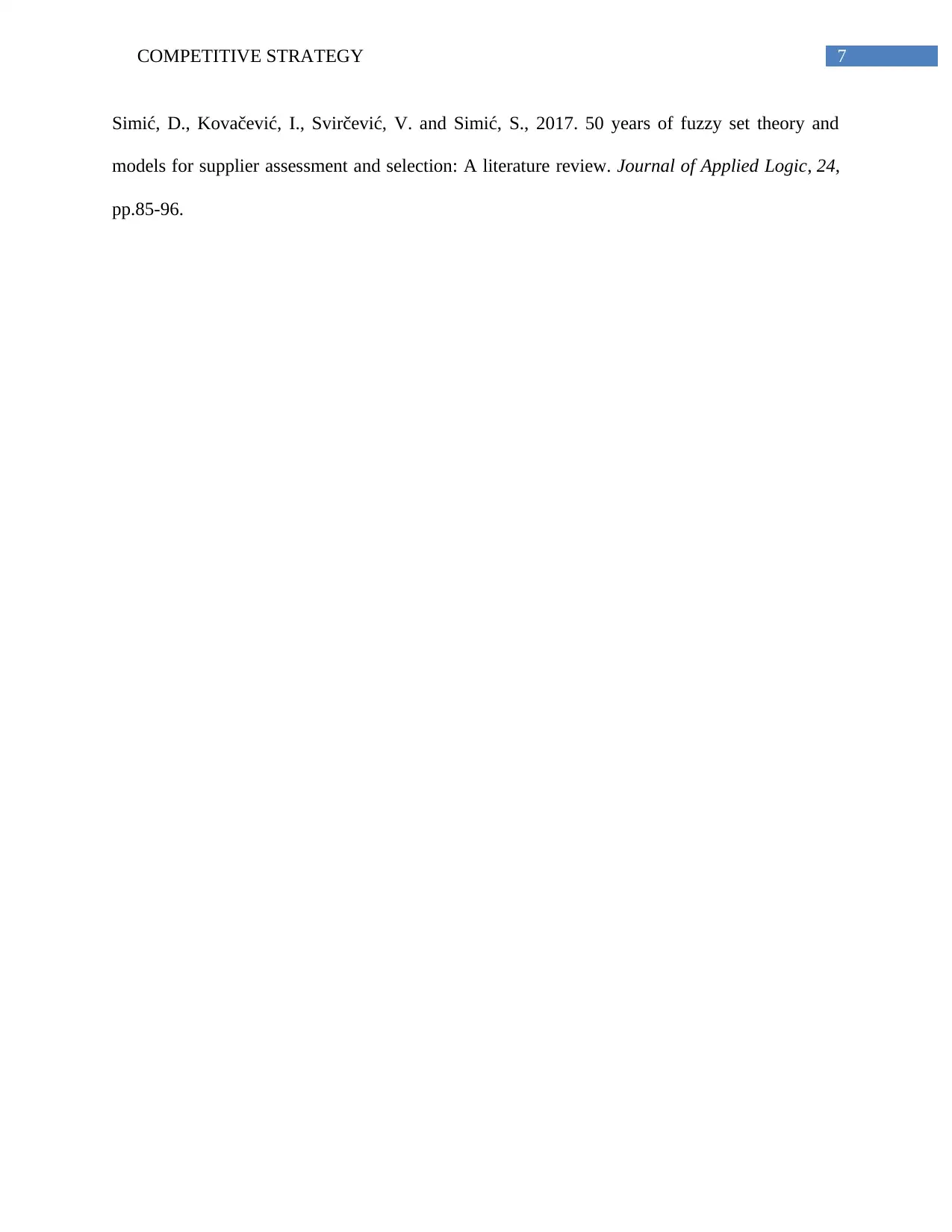
7COMPETITIVE STRATEGY
Simić, D., Kovačević, I., Svirčević, V. and Simić, S., 2017. 50 years of fuzzy set theory and
models for supplier assessment and selection: A literature review. Journal of Applied Logic, 24,
pp.85-96.
Simić, D., Kovačević, I., Svirčević, V. and Simić, S., 2017. 50 years of fuzzy set theory and
models for supplier assessment and selection: A literature review. Journal of Applied Logic, 24,
pp.85-96.
1 out of 8
Related Documents
Your All-in-One AI-Powered Toolkit for Academic Success.
+13062052269
info@desklib.com
Available 24*7 on WhatsApp / Email
![[object Object]](/_next/static/media/star-bottom.7253800d.svg)
Unlock your academic potential
© 2024 | Zucol Services PVT LTD | All rights reserved.




